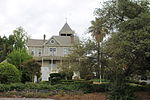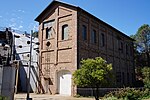Murer House and Gardens
1927 establishments in CaliforniaBuildings and structures in Folsom, CaliforniaCalifornia stubsMuseums established in 1927Museums in California

The Murer House and Gardens in Folsom, California is a building, designed and built by Giuseppe Murer in the Italian Renaissance architecture style, built in 1927. The house currently operates as a museum, and showcases the history of Italian immigration to the US and the early formation of Folsom. The Murer House and Gardens was listed on the National Register of Historic Places in 2022.
Excerpt from the Wikipedia article Murer House and Gardens (License: CC BY-SA 3.0, Authors, Images).Murer House and Gardens
Fong Street, Folsom
Geographical coordinates (GPS) Address Nearby Places Show on map
Geographical coordinates (GPS)
| Latitude | Longitude |
|---|---|
| N 38.673422222222 ° | E -121.18229166667 ° |
Address
Fong Street 1316
95630 Folsom
California, United States
Open on Google Maps






